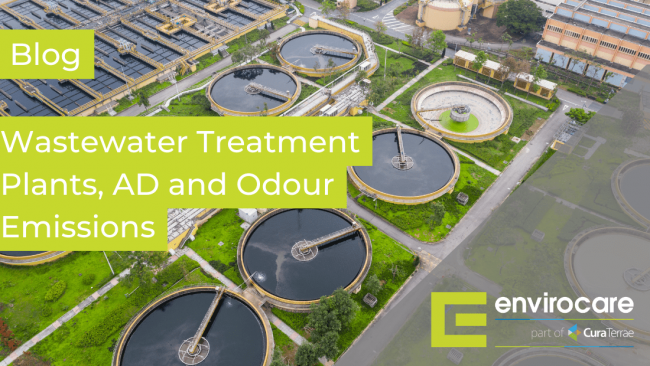Wastewater Treatment Plants, Anaerobic Digestion, and Odour Emissions Explained
22 September 2015

Anaerobic digestion can and is playing a huge role in creating a potential fuel source from waste that is otherwise seen to have little use. Within the wastewater treatment industry, sludge is produced as a waste and has to be disposed of safely and effectively, which is where anaerobic digestion can play an important role by producing electricity and heat from a resource that would otherwise be unused.
The Wastewater Treatment Process
Wastewater treatment consists of several stages that result in the water being safe both to humans and the environment. These stages consist of:
- Primary Treatment: Temporary retention of the sewage within a basin to allow heavy solids to settles to the bottom while the oil, grease and lighter solids to float to the surface. The settled and floating liquids are then removed and the remaining liquid is then subjected to secondary treatment
- Secondary Treatment: This stage removes dissolved and suspended biological matter, using indigenous, water-borne micro-organisms in a managed habitat.
- Tertiary treatment: This final stage prepares the liquid to be released into potentially fragile or sensitive ecosystems, such as estuaries, low-flow rivers or coral reefs. This is often done through disinfecting the water through the use of chemicals or physically, for example using lagoons and microfiltration.
The solids removed through the wastewater treatment process is known as ‘sludge’. Sludge is produced as a by-product and can be used within The Anaerobic Digestion Process to produce methane that can in turn be combusted in a Combined Heat and Power Plant (CHP) to produce electricity and heat.
Regulations
Odours are a common occurrence at wastewater treatment plants and some anaerobic digesters. If these odours are not monitored correctly, there is a potential for them to have effects not only on peoples health, but also on aesthetics, property prices and quality of life in nearby communities. Toxic odours that affect peoples health are carefully controlled by air quality regulations.
It can be quite common for biogas to require some treatment before it is burnt, as hydrogen sulphide and other contaminants are released as a trace component of the biogas. The Environment Agency has strict limits on gases that contain hydrogen sulphide and therefore sites where there is potential for it to be emitted need to be monitored.
Experts In Wastewater Treatment Plant Emissions
Envirocare offers a fully MCERTS & UKAS accredited Emissions Monitoring Service and consultancy advice to wastewater treatment plants and anaerobic digestion facilities.
The monitoring of exhaust gas emissions from anaerobic digestion process operators is a mandatory requirement. Operators who burn biogas in combustion engines to produce electricity are required to have the emissions of CO, NOx, VOC & SO2 assessed annually to demonstrate compliance with limits.
The Monitoring of Odour from a wastewater treatment facility or sewage treatment plant is also important to ensure there are no unpleasant or dangerous gases escaping or being given off during the storage or combustion of the gas.
Call us on 01274 738668 or fill out our Envirocare Enquiry Form for any queries regarding our wide range of emissions monitoring services.
